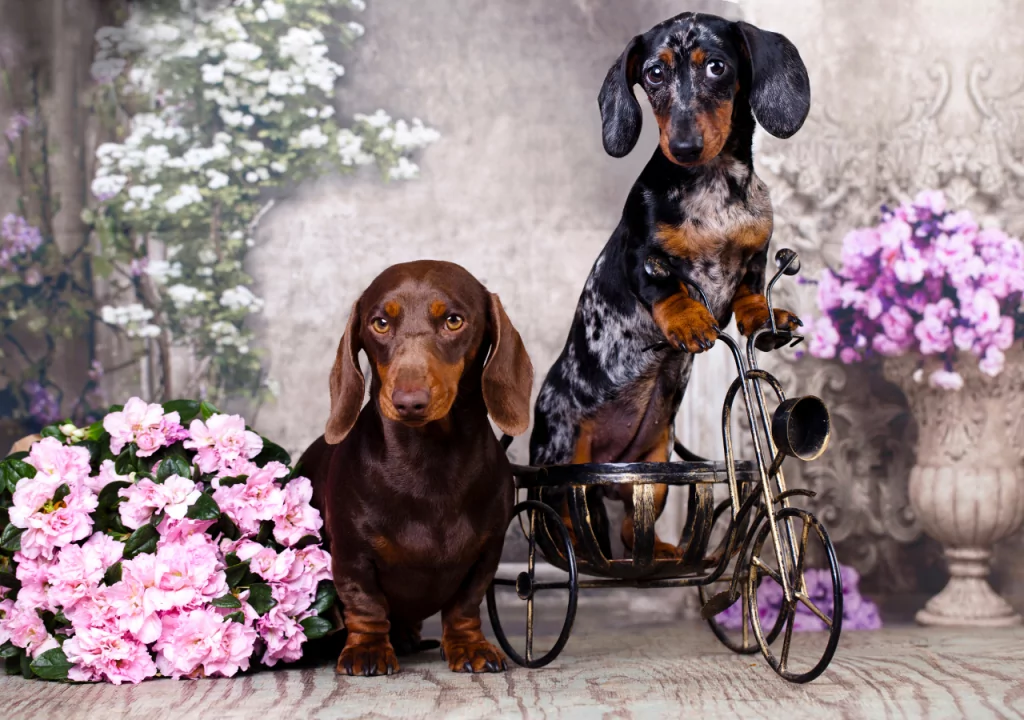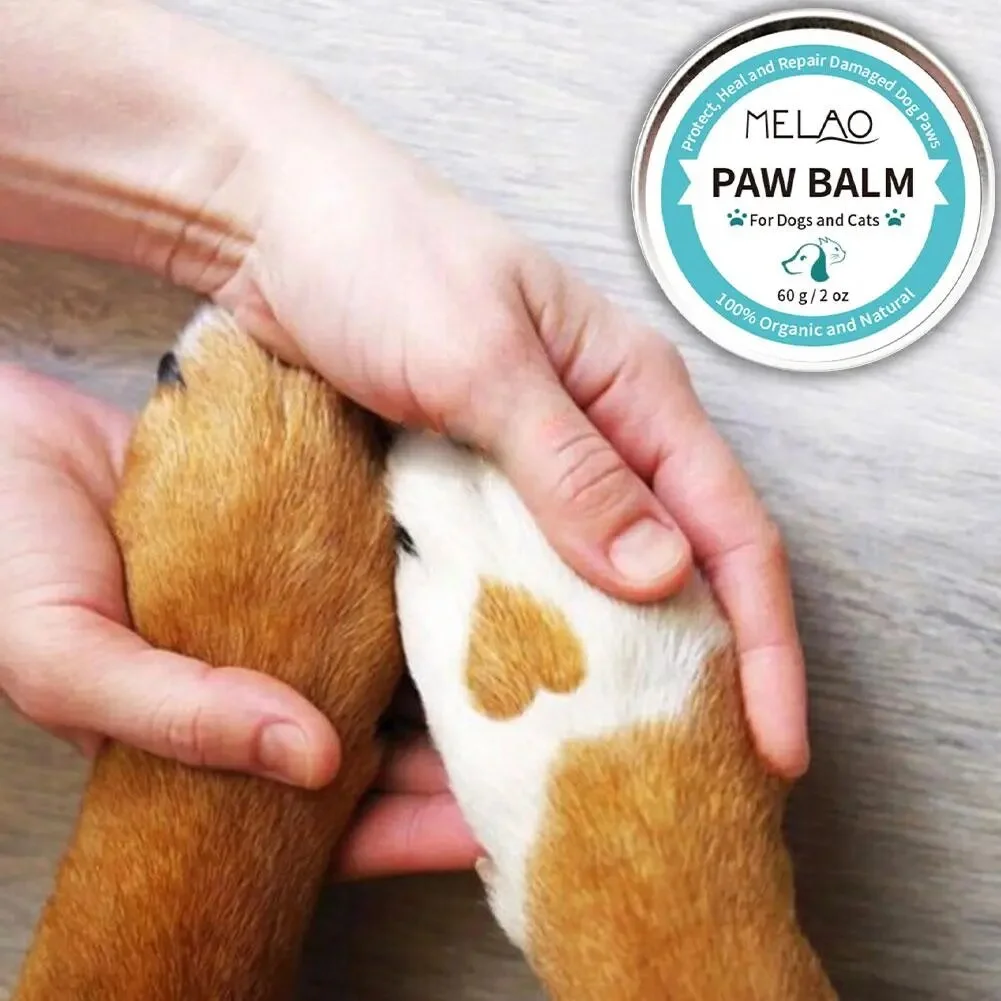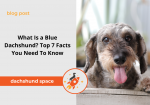Ever wondered how the Blue Dachshund came to be? It’s not just a matter of dipping a regular Dachshund in some blue paint and calling it a day. There’s history, genetics, and a bit of mystery wrapped up in their origin story. Let’s discover it together.
Historical Background of Dachshunds
Doxies have been around for hundreds of years. Originally bred in Germany to hunt badgers, their name literally translates to “badger dog” in German. Over time, these pups weren’t just hunting dogs. They became popular picks for families with kids and those who love active lifestyles. Wiener dogs are loyal, possess bold personalities, and unique, elongated appearance.
But when did the blue dachshund strut onto the scene? Pinpointing the exact moment is a bit tricky. The first recorded blue Dachshund is a bit of a mystery, as detailed breeding records for coat colors weren’t always meticulously kept. However, what’s known is that the blue variation became notably recognized and documented in breeding circles in the late 20th century. This wasn’t a sudden mutation but rather a rare color that gained popularity among breeders and pet lovers alike for its uniqueness and beauty.

Genetic Mutation in a Blue Dachshund
The blue color in Dachshunds isn’t about being blue in the way you’d think. It’s not the blue of the sky or the ocean but a diluted black coat color. It more looks like a silver or mouse gray color just with a bit of a so-called ‘blue hue’.
This color comes from a genetic mutation affecting the Dachshund’s coat color genes, specifically the dilute gene (d allele). When a Dachshund inherits this gene from both parents, the result is a stunningly beautiful blue-gray hue that makes the blue Dachshund stand out from its fellow wiener dogs.
The genetics behind the blue Dachshund are fascinating but come with a side note. This same dilute gene can sometimes lead to health considerations, particularly affecting the skin and coat. Some studies showed that doxies with blue coats are on a higher tendency to suffer from certain health issues. Therefore, you should wisely choose a breeder when buying a Dachshund puppy. It’s a reminder that beauty in the dog world isn’t just skin (or fur) deep—it’s genetic!
So, the creation of the blue Dachshund wasn’t a single event but a gradual emergence through selective breeding and the natural occurrence of genetic variation. While we may not be able to mark a calendar with the birthday of the first blue Dachshund, we can appreciate the journey of genetics, breeding, and a dash of serendipity that brought us these unique and captivating companions.
Physical Characteristics
Diving into the world of Dachshunds, it’s not just their spirited personalities that capture hearts, but their striking physical attributes too. From their unique color palette to the variety of coat types and distinctive size and shape, these little dogs pack a lot of charm into a small package.
Unique Color
When we talk about unique color, Dachshunds really take the cake. Beyond the standard reds and blacks, Dachshunds sport a variety of rare and eye-catching coat colors. Among these, the Blue Dachshund shines with its mesmerizing blue-gray hue, a result of a specific dilute gene. But the rainbow doesn’t stop there; Dachshunds also come in Isabella (a fawn or lilac color), chocolate, and even cream. Each color variation has its own special appeal, making every Dachshund distinct.

Coat Types of a Blue Dachshund
Smooth Coat:
This coat type is sleek and short, offering a glossy appearance. A Blue Dachshund with a smooth coat has a coat that’s easy to care for, requiring minimal grooming compared to the other types.
Long-haired:
Featuring a luxurious, silky coat that flows elegantly, the long-haired Blue Dachshund is a sight to behold. Their longer fur can highlight the unique blue-gray color beautifully, but it does require regular grooming to keep it free from mats and tangles.
Wire-haired:
The wire-haired Blue Dachshund has a coat that’s coarse and bristly to the touch, with a distinctive beard and eyebrows that add to their expressive appearance. This coat type adds a rugged charm to the blue coloring and also requires regular grooming to maintain its condition.
Coat Color Combinations of a Blue Dachshund
Solid Blue: A rare and striking look, solid blue Dachshunds have a uniform blue-gray coat with no other colors or patterns. This is the result of the dilution gene acting on a black base coat.
Blue and Tan:
One of the more common combinations, blue and tan Dachshunds have a blue-gray body with tan markings over the eyes, on the muzzle, chest, paws, and under the tail. This mirrors the traditional black and tan pattern but with the black diluted to blue.
Blue and Cream:
Similar to the blue and tan, but with cream replacing the tan markings. The cream can range from a light, almost white, to a deeper, richer cream.
Blue Dapple (or Merle):
Dapple (or merle) refers to a pattern of darker patches scattered over a lighter base coat. Blue dapple Dachshunds have a blue-gray base with patches of darker blue or even black. This dapple effect can be quite striking and varies greatly from one dog to another.

Double Blue Dapple:
A more intensified dapple pattern, where the dog has the dapple gene from both parents. This results in a more mottled appearance, with more extensive dapple patterning throughout the coat. Double dapple Dachshunds can sometimes have blue eyes or even one blue and one brown eye.
Blue Brindle:
Brindle Dachshunds have a tiger-stripe pattern, and in blue brindles, this pattern is overlaid on a blue-gray base. The stripes can vary in intensity and distribution, making each blue brindle Dachshund unique.
Blue Piebald:
Piebald Dachshunds have large areas of white on their bodies, breaking up the primary color. A blue piebald would have a blue-gray and white coat, with the pattern distribution affecting the overall appearance significantly.
Size and Shape of blue Dachshunds
Despite their variety in color and coat, all Dachshunds share a unique size and shape that is unmistakable. With their long bodies, short legs, and vivacious expressions, Dachshunds are designed for agility and flexibility, traits that historically made them excellent hunters. This design, while adorable, also means owners need to be mindful of their Dachshund’s back health, avoiding activities that could cause injury to their distinctive spines.
Lifespan of Dachshunds
Speaking of their well-being, the lifespan of a Dachshund is a testament to their hardiness and the care they receive from their owners. On average, a Dachshund can enjoy a life full of belly rubs and treats for 12 to 16 years. Of course, factors like genetics, diet, exercise, and preventive healthcare play critical roles in ensuring your Dachshund lives a long, happy life. In case you own or you want to buy a blue Doxie, then we recommend you to pay a special attention to their diet.
They are more prone to food allergies so feeding them with dry kibble rich in artificial colors and additives can harm their health. Besides your Doxie can experience digestive issues, he can also develop rash, and different skin bumps. We don’t even have to mention that his skin can become very itchy.
From their unique color variations and coat types to their distinctive size and shape, Dachshunds are truly a breed like no other. And with a lifespan that can stretch well into their teens, these little dogs promise years of companionship and love. Whether you’re drawn to the rare hues of their coats or their spirited personalities, one thing’s for sure: life with a Dachshund is never dull.

7 Interesting Facts About Blue Dachshunds
Blue doxies are one of the most popular dogs among rare dachshunds. They’re often high in price because not only because of their inuqueness but also because of the breeding practices. Here are some of the facts you need to know about these gorgeous blue beauties.
Rarity
The rarity of Blue Dachshunds and other rare Dachshunds adds to their allure. Among these, Blue Dachshunds have their own fan base, thanks to that gorgeous blue-gray coat. But wait, there’s more! When it comes to the rarest Dachshund, the Double Dapple Dachshund steals the spotlight with its unique eye color (often blue) and distinctive dapple pattern. These pups are like the unicorns of the Dachshund world—super rare and absolutely magical.
Health Considerations
Now, onto the not-so-fun part—health considerations. Blue Dachshunds, due to their unique genetic makeup, can be predisposed to certain skin and coat issues, such as Color Dilution Alopecia. It’s something to keep in mind, ensuring your blue buddy gets the right care and attention to keep their coat as stunning as their personality.

Temperament
Temperament time! Dachshunds, no matter the color, are little packages of joy, bravery, and stubbornness. They’re lively, playful, and can be quite the little warriors, which sometimes means they’re not aware of their own size. This makes for hilarious and heartwarming moments, showing that big personalities do come in small packages.
Care Requirements
When it comes to care requirements, Dachshunds, especially those with rare coats, need a bit of extra TLC. Regular vet check-ups, a balanced diet, and proper grooming can go a long way. And don’t forget the importance of back care! Keeping them from jumping off high places is key to avoiding potential back issues.
Lifespan
The lifespan of a Dachshund, including the rare and beautiful Blue ones, ranges impressively from 12 to 16 years. This means you get to enjoy the delightful company of your elongated buddy for a good long while, creating countless memories along the way.
Suitability for Families
As for suitability for families, Dachshunds are great! They adore being part of the pack and can get along wonderfully with kids, especially if they grow up together. Their protective nature and boundless energy make them fantastic playmates and watchdogs.
Price and Availability of a Blue Dachshund
Due to their rarity, Blue Dachshunds and other uncommon variations like the Double Dapple can fetch a higher price tag. The average price of a Blue Dachshund can vary widely depending on several factors, including the breeder’s reputation, the dog’s lineage, and whether the puppy comes with registration papers and health clearances.
Generally, for a Blue Dachshund from a reputable breeder, you might expect to pay anywhere from $1,000 to $3,000 or more. This price range reflects the rarity of the coat color, as well as the special care and attention that reputable breeders invest in their breeding programs to ensure the health and well-being of the puppies.
Are Blue Dachshunds more prone to health issues?
Yes, the dilute gene can predispose them to certain skin and coat conditions, requiring careful management. Unfortunately, dogs with blue coats have a higher tendency to suffer from allergies and skin-related health issues.
Therefore, you need to think about how to keep them safe when taking them outside in cold and hot weather. Blue Dachshunds often have sensitive pink noses and paw pads, so their owners should protect their paws with protective shoes.
Swoosh Dachshund Shoes are one of the most popular picks among our customers not only because of the comfort but also because of the design. They feature non-slipping sole and a sporty design that catches everyone’s eye.

Don’t forget to regularly soothe their paw pad with a protective balm such as the Natural Dachshund Paw Balm. It will make your dog’s paws soft and will also give a dose of protection when walking on hot or cold pavements.

Choosing a blue Dachshund: Wrapping up
Regardless of what type of rare Dachshund puppy you choose for your home, one thing is for sure! These adorable pooches steal our hearts at first sight. They are loyal, and playful and will fill every ‘’inch’’ of your life with joy and a smile.



2 thoughts on “What Is a Blue Dachshund? Top 7 Facts You Need To Know”